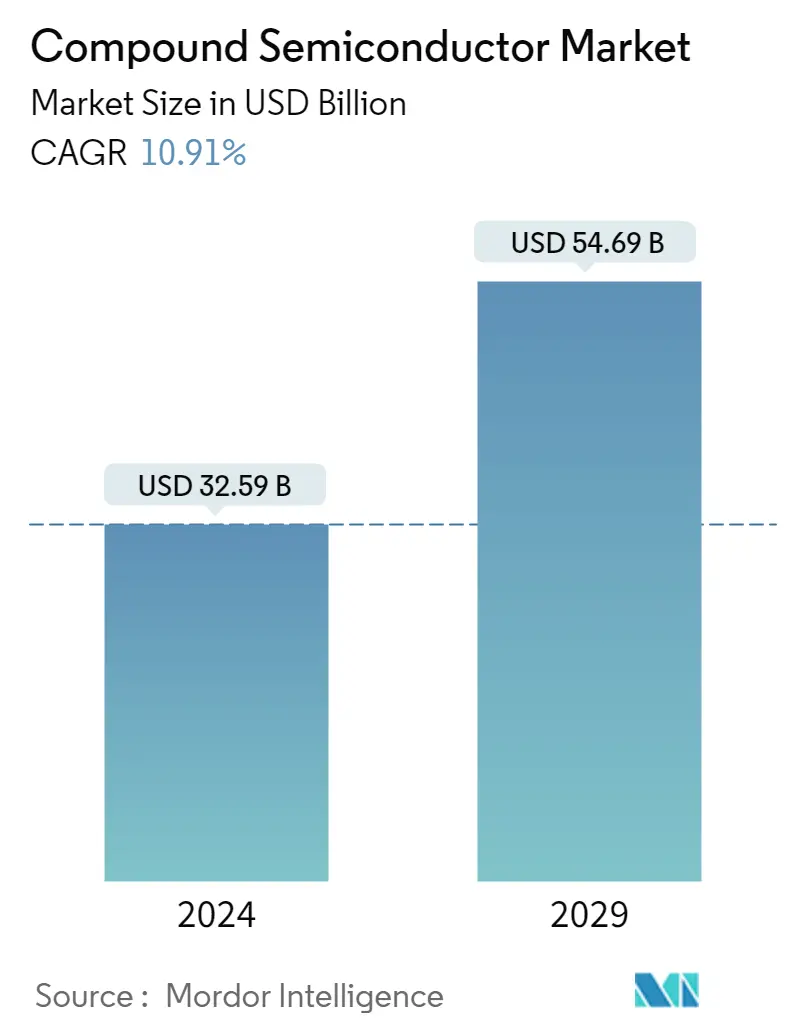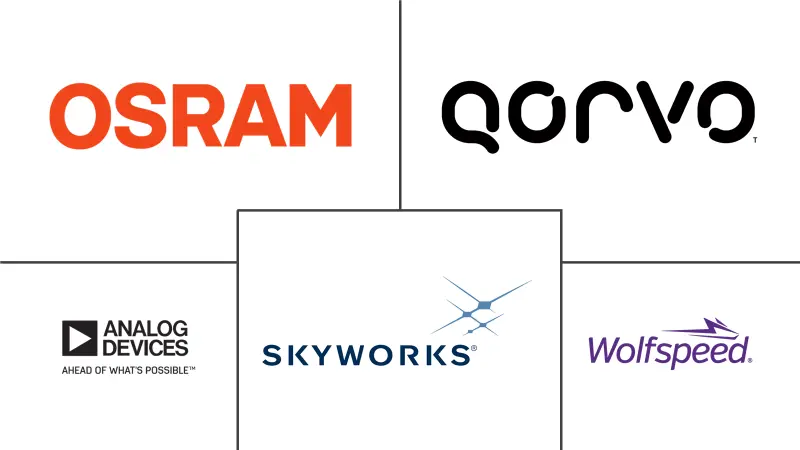Market Size of Compound Semiconductor Industry

| Study Period | 2019 - 2029 |
| Market Size (2024) | USD 32.59 Billion |
| Market Size (2029) | USD 54.69 Billion |
| CAGR (2024 - 2029) | 10.91 % |
| Fastest Growing Market | Middle East and Africa |
| Largest Market | Asia-Pacific |
Major Players*Disclaimer: Major Players sorted in no particular order |
Compound Semiconductor Market Analysis
The Compound Semiconductor Market size is estimated at USD 32.59 billion in 2024, and is expected to reach USD 54.69 billion by 2029, growing at a CAGR of 10.91% during the forecast period (2024-2029).
The COVID-19 pandemic halted the manufacturing of several products in the compound semiconductor production industry owing to continued lockdown in critical global regions. In addition, country-wise lockdowns inflicted by governments across the globe further resulted in sectors taking a hit and disrupting supply chains and manufacturing operations worldwide. Most manufacturing operations, including the factory floor work, were significantly affected, resulting in decreased productivity.
- Compound semiconductors are made from two or more elements of the different or same group of the periodic table. These are manufactured by using various types of deposition techniques, such as chemical vapor deposition, atomic layer deposition, and others. They possess unique properties like high temperature and heat resistance, enhanced frequency, high sensitivity to magnetism, and faster operation and optoelectronic features are some of the key advantages boosting their demand. Moreover, the decrease in the manufacturing cost of compound semiconductors has increased their application in electronic and mobile devices.
- The ability of compound semiconductors to emit and sense light in the form of general lighting (LEDs) and lasers and receivers for fiber optics is further driving the demand. The decrease in manufacturing and installation cost of LEDs has increased its application in lamps and fixtures across all sectors. Mega-cities concentrate on investing in infrastructure development to meet the needs of the growing population, and governments are helping customers to install energy-efficient lighting sources to reduce their electricity consumption costs.
- For instance, during the pandemic, EESL (Energy Efficiency Services Limited) celebrated the completion of its one-year governmental project called the Unnat Jyoti Program (UJALA). Under this program, it substituted more than 10.6 million street light bulbs with LED lights to reduce the carbon dioxide footprint by 20 million tons and the electricity cost. Such initiatives further boost the market studied.
- In 2020, the Taiwan Semiconductor Manufacturing Company (TSMC) sourced about 31% of spare parts locally in China, which increased to 31% in 2021.
- According to the US Department of Energy (DOE), LED lights use about 75-80% less energy than traditional incandescent light bulbs and about 65% less energy than halogen bulbs. Commercial enterprises need lighting for an extended period, whether for long working hours, safety and security in a warehouse or manufacturing facility, or other uses. Thus, switching to LED lights can save millions of dollars annually. For example, US Energy Recovery clients can save about 20-55% on their electric utility bills by swapping out old lighting systems for state-of-the-art LED lighting. Therefore, the shift toward LED adoption is driving the growth of the market studied.
- The smartphone is the major consumer of compound semiconductors. The smartphone market has been very competitive in recent years. The increasing usage of mobile phones is further anticipated to drive the global market. For instance, according to the Ericsson Mobility Report, 2022, by the end of 2027, there will be 4.4 billion 5G subscriptions globally, accounting for 48% of all mobile subscriptions.
- The Internet of Things applications are increasing, which is expected to boost the sales of compound semiconductors. Moreover, the wireless communications sector is expected to grow with the growth in 5G networks. Fifth-generation networks also indicate the likelihood of consumers upgrading their mobile handsets or devices to drive global compound semiconductor adoption.
- The compound semiconductor industry is considered one of the most complex industries, not only due to the more than 500 processing steps involved in the manufacturing and various products but also due to the harsh environment it faces, e.g., the volatile electronic market and the unpredictable demand.
Compound Semiconductor Industry Segmentation
A semiconductor made of two or more elements is called a compound semiconductor, and the silicon of the semiconductor is made from a single element. The studied market is segmented by Type, such as Gallium Arsenide (GaAs), Gallium Nitride (GaN), Gallium Phosphide (GaP), Silicon Carbide (SiC)), Product (LED RF, Optoelectronics, and Power Electronics among various applications such as Telecommunications, Information & Communication Technology, Defense & Aerospace, Consumer Electronics, Healthcare, Automotive in multiple geographies. Further, the impact of macroeconomic trends on the Market is also covered under the scope of the study. Further, the disturbance of the factors affecting the Market's evolution in the near future has been covered in the study regarding drivers and constraints. The market sizes and predictions are provided in terms of value in USD for all the above segments.
| By Type | |
| Gallium Arsenide (GaAs) | |
| Gallium Nitride (GaN) | |
| Gallium Phosphide (GaP) | |
| Silicon Carbide (SiC) | |
| Others |
| By Product | |
| LED | |
| RF | |
| Optoelectronics | |
| Power Electronics | |
| Other Products |
| By Application | |
| Telecommunications | |
| Information & Communication Technology | |
| Defense & Aerospace | |
| Consumer Electronics | |
| Healthcare | |
| Automotive | |
| Other Applications |
| By Geography | ||||||
| ||||||
| ||||||
| ||||||
| Latin America | ||||||
| Middle East and Africa |
Compound Semiconductor Market Size Summary
The compound semiconductor market is poised for significant growth, driven by its unique properties and increasing applications across various sectors. These semiconductors, composed of two or more elements from the periodic table, are manufactured using advanced deposition techniques and are known for their high temperature resistance, enhanced frequency capabilities, and faster operation. The demand for compound semiconductors is bolstered by their application in optoelectronics, such as LEDs and lasers, which are increasingly used in general lighting and fiber optics. The reduction in manufacturing costs has further expanded their use in electronic and mobile devices, with smartphones being a major consumer. The rise of the Internet of Things and the expansion of 5G networks are expected to further drive the adoption of compound semiconductors, as these technologies require advanced semiconductor solutions for improved performance and efficiency.
The market is characterized by intense competition, with major players like Broadcom, Skyworks Solutions, and Cree dominating the landscape. These companies are focusing on expanding their global presence and enhancing their product offerings through strategic partnerships and technological advancements. The compound semiconductor industry is also witnessing growth in regions like the Middle East and Africa, where initiatives to develop 5G networks and renewable energy projects are creating new opportunities. Additionally, advancements in optoelectronic products and the increasing demand for energy-efficient solutions are contributing to the market's expansion. As the industry continues to evolve, both large and mid-size companies are leveraging innovations and strategic collaborations to capture a larger share of the growing market.
Compound Semiconductor Market Size - Table of Contents
-
1. MARKET INSIGHTS
-
1.1 Market Overview
-
1.2 Industry Value Chain Analysis
-
1.3 Industry Attractiveness - Porter's Five Forces Analysis
-
1.3.1 Bargaining Power of Suppliers
-
1.3.2 Bargaining Power of Buyers
-
1.3.3 Threat of New Entrants
-
1.3.4 Threat of Substitutes
-
1.3.5 Intensity of Competitive Rivalry
-
-
1.4 Assessment of Impact of Macroeconomic Trends on the Market
-
-
2. MARKET SEGMENTATION
-
2.1 By Type
-
2.1.1 Gallium Arsenide (GaAs)
-
2.1.2 Gallium Nitride (GaN)
-
2.1.3 Gallium Phosphide (GaP)
-
2.1.4 Silicon Carbide (SiC)
-
2.1.5 Others
-
-
2.2 By Product
-
2.2.1 LED
-
2.2.2 RF
-
2.2.3 Optoelectronics
-
2.2.4 Power Electronics
-
2.2.5 Other Products
-
-
2.3 By Application
-
2.3.1 Telecommunications
-
2.3.2 Information & Communication Technology
-
2.3.3 Defense & Aerospace
-
2.3.4 Consumer Electronics
-
2.3.5 Healthcare
-
2.3.6 Automotive
-
2.3.7 Other Applications
-
-
2.4 By Geography
-
2.4.1 North America
-
2.4.1.1 United States
-
2.4.1.2 Canada
-
-
2.4.2 Europe
-
2.4.2.1 Germany
-
2.4.2.2 France
-
2.4.2.3 Italy
-
2.4.2.4 Rest of Europe
-
-
2.4.3 Asia Pacific
-
2.4.3.1 China
-
2.4.3.2 Japan
-
2.4.3.3 India
-
2.4.3.4 Rest of the Asia Pacific
-
-
2.4.4 Latin America
-
2.4.5 Middle East and Africa
-
-
Compound Semiconductor Market Size FAQs
How big is the Compound Semiconductor Market?
The Compound Semiconductor Market size is expected to reach USD 32.59 billion in 2024 and grow at a CAGR of 10.91% to reach USD 54.69 billion by 2029.
What is the current Compound Semiconductor Market size?
In 2024, the Compound Semiconductor Market size is expected to reach USD 32.59 billion.


